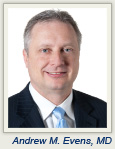The 11th International Conference on Malignant Lymphoma was held June 15–18 in Lugano, Switzerland. Topics of discussion included lymphoma staging in the new millennium, lymphoma and its microenvironment, and lymphoma cure vs control. The ASCO Post summarized several key presentations in the July 1, 2011, issue. Here is continued coverage of the conference.
Study Design
 In the Intergroup E2496 trial,1 patients with advanced-stage Hodgkin lymphoma were randomly assigned to ABVD (doxorubicin, bleomycin, vinblastine, and dacarbazine) for six to eight cycles plus radiation therapy for bulky mediastinal disease or the Stanford V regimen (doxorubicin, vinblastine, mustard, vincristine, bleomycin, etoposide, prednisone) consisting of 12 weeks of chemotherapy and radiation of 36 Gy to sites greater than 5 cm. Among 812 patients enrolled, 43 were aged 60 years or older (median age of 65 years, 69% with stage III disease, 47% with B symptoms, and 16% with International Prognostic Index ≥ 4), with 23 randomly assigned to ABVD and 22 to Stanford V.
In the Intergroup E2496 trial,1 patients with advanced-stage Hodgkin lymphoma were randomly assigned to ABVD (doxorubicin, bleomycin, vinblastine, and dacarbazine) for six to eight cycles plus radiation therapy for bulky mediastinal disease or the Stanford V regimen (doxorubicin, vinblastine, mustard, vincristine, bleomycin, etoposide, prednisone) consisting of 12 weeks of chemotherapy and radiation of 36 Gy to sites greater than 5 cm. Among 812 patients enrolled, 43 were aged 60 years or older (median age of 65 years, 69% with stage III disease, 47% with B symptoms, and 16% with International Prognostic Index ≥ 4), with 23 randomly assigned to ABVD and 22 to Stanford V.
In an analysis of characteristics and outcomes in this older group, Andrew M. Evens, DO, MSc, and colleagues from the Intergroup E2496 study found a number of differences between older and younger patients, including a greater frequency of mixed cellularity type (35% vs 13%, P = .0004) and lower proportion with ECOG performance status of 0 (35% vs 58%, P = .004). Dose reductions were required in 84% of elderly patients. There were no statistically significant differences in grade 3 or 4 toxicities (by CTCAE criteria) between older and younger patients; however, the incidence of bleomycin lung toxicity occurred in 26% of older patients, which had an associated mortality rate of 18%. Furthermore, the treatment-related morality rate was 9.3% for elderly patients (2 deaths in each arm, 2 due to bleomycin lung toxicity) compared with 0.3% for patients < 60 years old (P < .0001).
A Focus on Elderly Patients
 Among all elderly patients, there were no differences between the two treatment groups with regard to patient characteristics, overall response rate, complete response rate, failure-free survival, or overall survival; the treatment arms were thus pooled for an exploratory comparison of outcomes between older and younger patients. There were no differences between older and younger patients in overall response rate (70% vs 78%, P = NS) or complete response rate (65% vs 71%, P = NS), but 3-year (55% vs 76%) and 5-year (46% vs 74%) failure-free survival (P = .0014) and 3-year (69% vs 93%) and 5-year (56% vs 90%) overall survival (P < .0001) were significantly lower in older patients.
Among all elderly patients, there were no differences between the two treatment groups with regard to patient characteristics, overall response rate, complete response rate, failure-free survival, or overall survival; the treatment arms were thus pooled for an exploratory comparison of outcomes between older and younger patients. There were no differences between older and younger patients in overall response rate (70% vs 78%, P = NS) or complete response rate (65% vs 71%, P = NS), but 3-year (55% vs 76%) and 5-year (46% vs 74%) failure-free survival (P = .0014) and 3-year (69% vs 93%) and 5-year (56% vs 90%) overall survival (P < .0001) were significantly lower in older patients.
Results Favor Younger Patients
According to Dr. Evens, who is Associate Professor of Medicine at the University of Massachusetts and lead author of the analysis, “This is one of the first reports from the United States in the past 10 to 15 years of a prospective clinical study in Hodgkin lymphoma that included elderly patients. Hodgkin lymphoma is relatively uncommon in the elderly, with most patients being diagnosed in their 20s or 30s.”
Dr. Evens said, “This analysis showed that although approximately half of the elderly patients are cured with ABVD or Stanford V therapy, progression-free survival and overall survival rates are significantly inferior to those in younger patients. Furthermore, the older vs younger survival rates appear to be disproportionately inferior compared with what we observe in other lymphoid malignancies. This report also confirms prior observations that elderly Hodgkin patients appear to have different disease biology and appear to endure more treatment-related toxicities, notably bleomycin lung toxicity. We need to continue to explore novel therapeutic options for elderly patients.” ■
Disclosure: Dr. Evens reported no potential conflicts of interest.
Reference
1. Evens AM, et al: Efficacy and tolerability of ABVD and Stanford V for elderly advanced-stage Hodgkin lymphoma (HL): Analysis from the phase III randomized US intergroup trial E2496 (Abstract 107).

